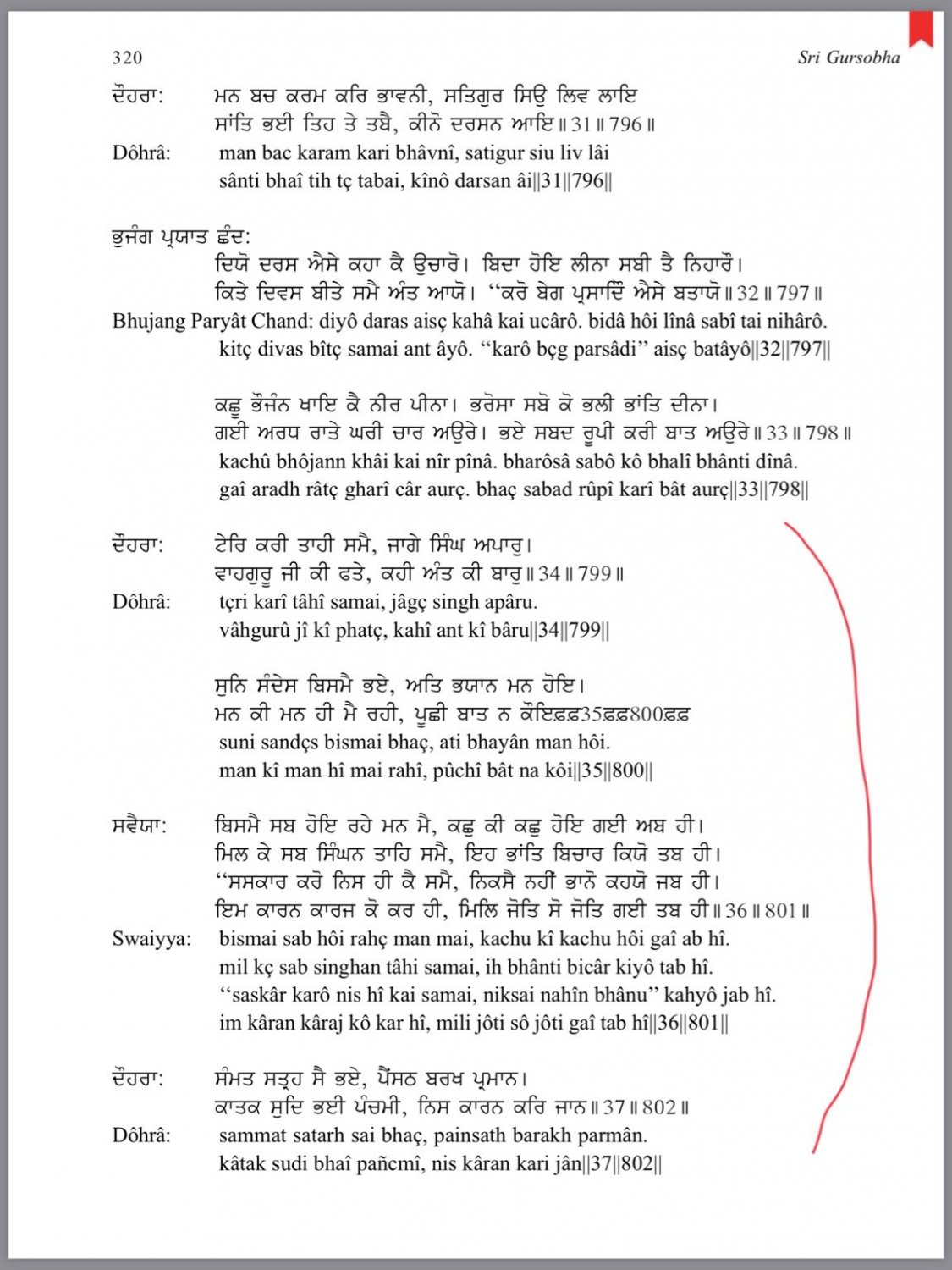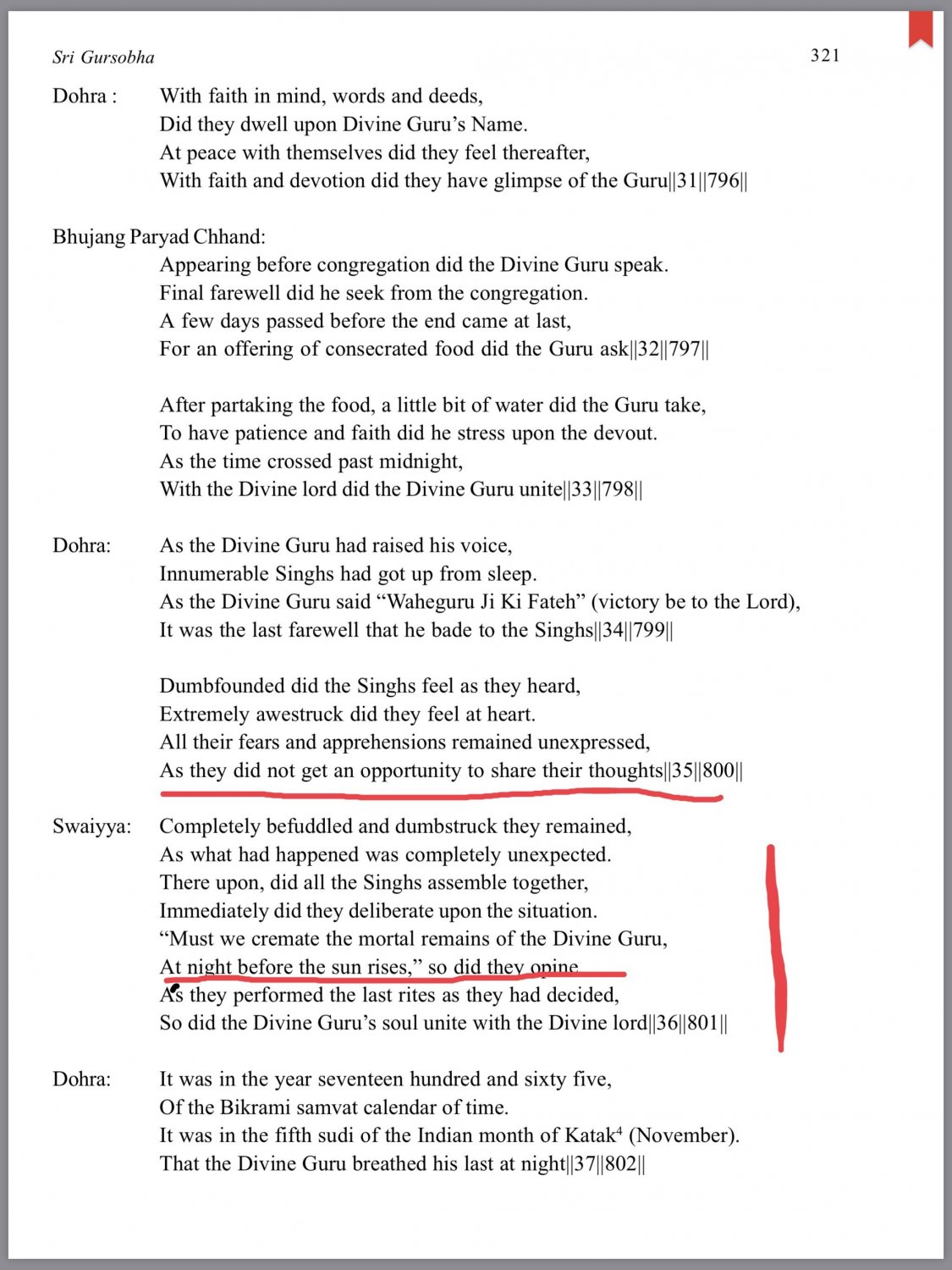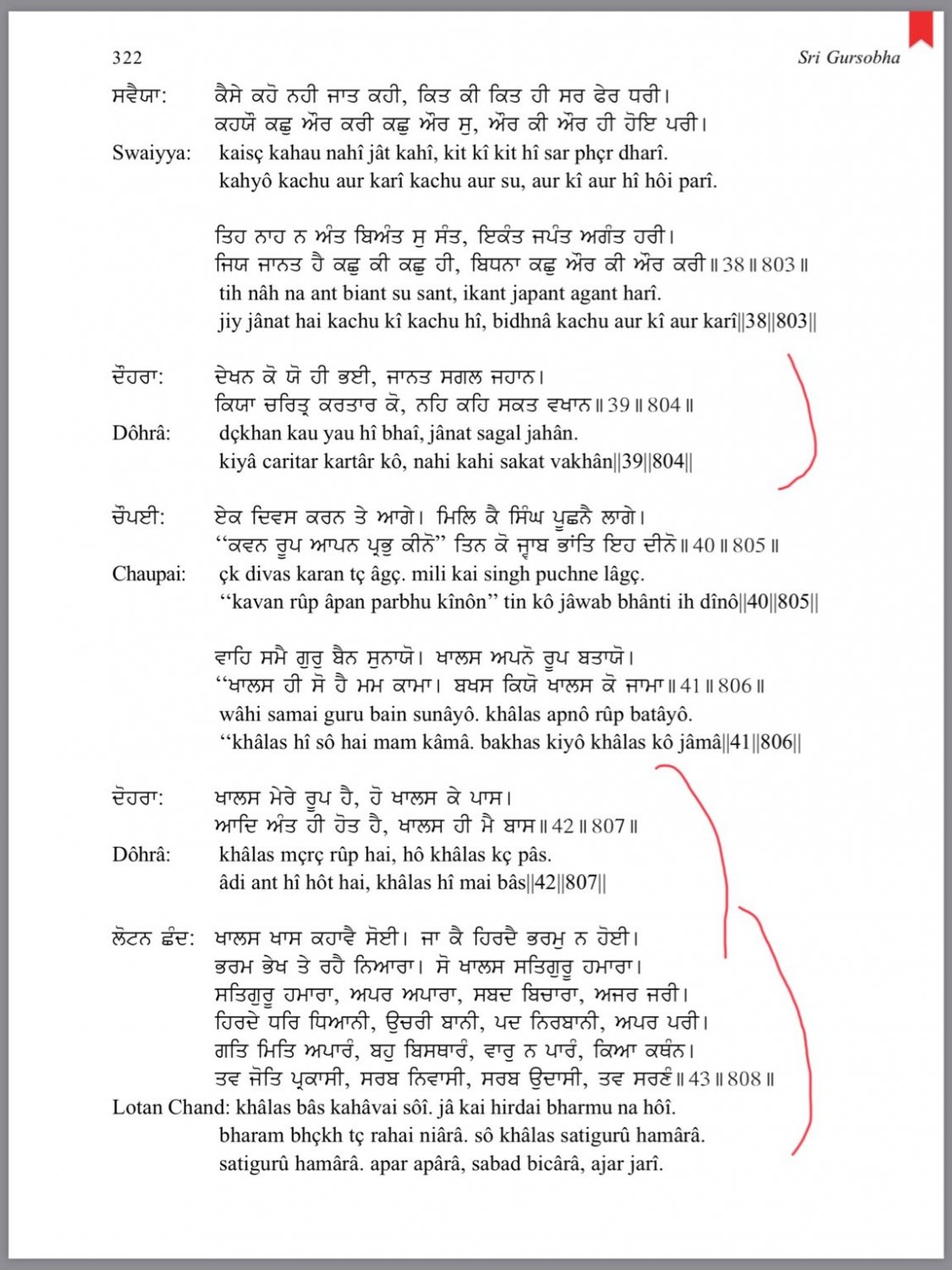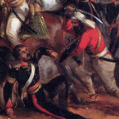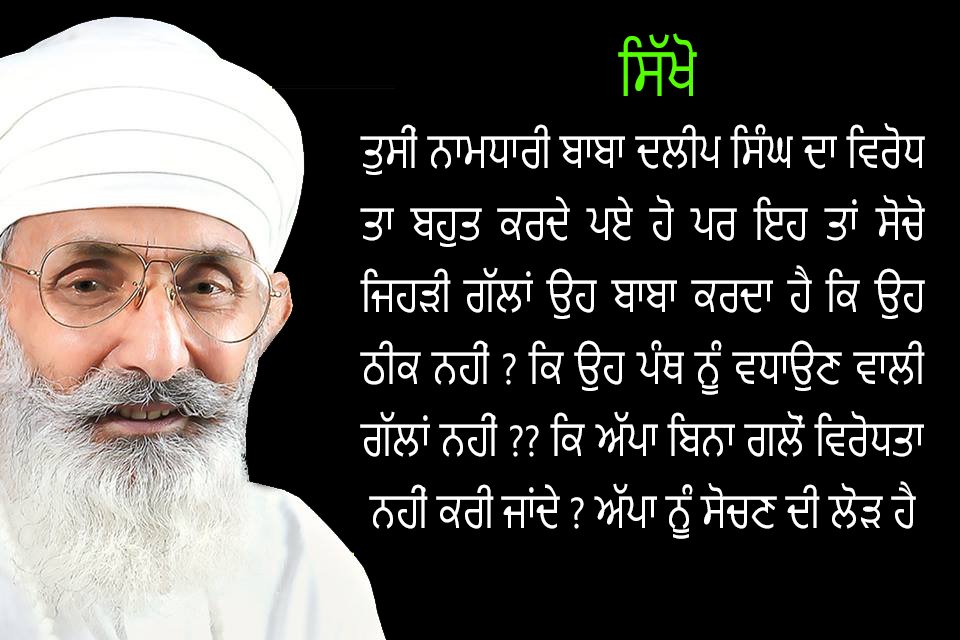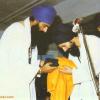Search the Community
Showing results for tags 'khalsa'.
-
Why we are called Sikhs? Sikh name to Sikh religion which Guru Ji gave. I am Sikh since generations. I am proud of being a Sikh. Sikhism is the best modern and progressive religion. Non Sikhs ask me and I want answers for the following questions. 1. Which Guru Ji started Sikh religion? 2. In which year Guru Ji started Sikh religion? 3. At which place Guru Ji started Sikh religion? 4. In which place and year Guru Ji declared that my religion name is “Sikh” 5. In which place and year which Guru Ji declared that my religion is a separate from others, and it is a separate Kaum also. If any Guru Ji made Sikhs a separate Kaum (nation) he must have written in SGGS. 6. Is our Sikh religion a religion or Kaum (nation) While answering please mention name of book and page, edition year etc. I tried very hard to find answers to these questions from old Janam Sakhis, Panth Prakash, Gur bilas, Suraj Prakash, Guru Granth Sahib, Bhai Gurdas Ji and Dasam Granth also. But no where it is written about my questions. Please do not quote from Modern history books. Please help me.
-
This is a thread to post ur favourite kirpana and other shastars (like their was this fav kirtan thread) mine personally is the sarabloh store 12 inch curved pesh kabz
-
Hi to all, So I have problem, maybe it's not even a problem, maybe it's my insecurities I don't know. So I'm ready to take Amrit 100%. I do my Paath, I don't remove no hair whatsoever and try to be a good human being in general. So I believe when I do take Amrit my head should be covered at all times . However I am having trouble with this. So I've been practicing the Dastar for many months now and it simply does not suit me. I know you are probably thinking I am silly for even writing this but it does not suit my face. I've also tried different styles. So i figured I would wear a patka instead but I have a weird shaped head or something (lol), I don't know but patka don't look good at all. I don't know why I am even writing this post, I guess most of the replies will tell me I have insecurity issues and need to be more confident. I'm not really insecure at all . I have slight facial hair on my upper lip. I often have people at work, other girls saying I need to wax but I couldn't care less what others think about it. However I just want to tie a nice dastar that suits my face. :( Is there any other people out there, that faced same issue with dastar, I've tried many styles :(
-
Waheguru ji ka khalsa, Waheguru ji ki Fateh. How and when will Khalsa rule come into existence? Dohira: Raj karega khalsa aki rahey na koye, Khuaar hoye sab milenge bache shrn jo hoye. Waheguru
-
- khalsa raj
- khalsa
-
(and 1 more)
Tagged with:
-
I have full faith in Sri Guru Granth Sahib Ji as a Guru because Guru Gobind Singh Ji gave “Gaddi” to Sri Guru Granth Sahib Ji. But, this belief is based upon the “Saakhi’s” stories, I heard from preachers and modern historians. They say Guru ji gave gaddi at Nanded (Hazur Sahib) in 1708. The point is where is ir written? In which authentic contemporary or old histoey books? Today by chance I came across the Punjabi and English Translation of “Gur Sobha” book by Senapati, a contemporary poet & historian in the court of Guru Gobind Singh Ji which suggests otherwise. I suggest everybody to read this book in Punjabi and English with translation which ever is convenient to you. Please read these pages particularly because they are eye opener. Especially Page no. 320, 21,22, 23. Here is the link for you to read and download book https://www.sikhinstitute.org/sri_gursobha.pdf On these pages it is very clear that Guru Ji did not give “Gaddi” to anyone; either to Sri Guru Granth Sahib Ji or Khalsa panth. I think we all should strive hard to know the truth about succession story from old history books like Gur Partap Suraj, Gur Bilas etc. and not believe in concocted stories by our preachers and so called modern historians.
- 13 replies
-
Can someone please let me know the upcoming Amrit Sanchaars in the UK? ASAP (prefer not missionary lol)
- 2 replies
-
- amrit sanchaars
- amrit sanchar
-
(and 5 more)
Tagged with:
-
Vjkk Vjkf faujo, can everyone list everything they know about what has been changed by the firangi colonizers and the singh sabha organization.
- 5 replies
-
- khalsa
- santan sikhi
-
(and 2 more)
Tagged with:
-
khalsa ji can anyone tell me what is salotar and sunehra in nihangs thanks das guest singh keep the faith bhul chuk maaf wgjkwgjf sat srii akaaaaaaaaaaaaaaaaaaaaaaal
-
Khalsa ji does anyone know where i can buy senchi sahibs in 2 volumes and for how much money they will cost me pl make your reply fast thanks keep the faith bhul chuk maaf daas guest singh waheguru ji da khalsa waheguru ji di fateh boooleee soo nihaaal saat srii akaaal
- 6 replies
-
- senchi
- senchi sahibs
- (and 11 more)
-

Why didn't Khalsa have its field day ? Or is it yet to come ?
Guest posted a topic in WHAT'S HAPPENING?
Sikhism as a community is one of the richest in terms of martyrs. Looking at our own history, especially of the 18th century , one would have thought that with so many martyrs , we might have had a bigger success in the temporal domain. But today , forget about spreading our dominion in a number of countries, we don't even have one. Well atleast the jews have israel. But Sikhs have a history richer than Jews I reckon, atleast in sense of martyrdom. We remember them everyday in our ardas "Jinna Singha Singhnia ne dharam het sis dite , Band Band kataye , Khopria luhaiya, Charkhadiya te chadhe" all are prime examples of jewels of the Sikh community from 18th century. To be a Shaheed , a martyr was in itself such a hallowed position , higher than being an emperor . But I wonder where did all that blood of martyrs go ? Or is it still somewhere ? I mean in a mystical sense. Wait let me explain. Jesus died and his followers were fed to lions for roughly 2 centuries until they finally conquered rome by converting emperor to christianity . But then ever since christianity spread by tip of sword Islam struggled in earlier years , but later on it too covered swathes of territory and spread by tip of swords. Hindus have dominated indian subcontinent since antiquity it seems. But what about the sikhs ? Why were we not able to spread our religion ? why didn't god bless sikhi with many nations as he blessed the hindus, muslims and christians ? -
Regarding touching any human being’s feet
ramneeksingh posted a topic in GURBANI | SAKHIAN | HISTORY
In SGGS or Gurbani, where it is written that “ Sikh should not bow and touch any human being’s feet particularly of a Saint”? -
On 30 April 1877 Britisher tried to put Harimandir Sahib (Golden Temple) on auction that got cancelled with the blessings of Guru Ramdas ji. Surprisingly this incident never been brought up by Sikhs since it was an act of Christians. Read full article. http://dailysikhupdates.com/british-built-gothic-tower-across-sri-darbar-sahib-1874/
-
This Is one of the best books out there when it comes to describing the revolutionary achievements of Sikhi in relation to caste during the early days of the Khalsa. It's essential reading in my opinion. Hope some people learn from it: https://ia802508.us.archive.org/17/items/TheSikhRevolutionAPerspectiveView/TheSikhRevolutionAPerspectiveView.pdf (stub link now updated for download)
- 55 replies
-
4
-
my dear Sikh brother just please think why we are opposing namdhari baba thakur dalip singh just think is not it what he is saying is not it that true and is not it that he is doing something for sikh panth ? is not it he grow sikhs or we are just opposing without giving second thought we should re think
-
Vaheguru Ji Ka Khalsa Vaheguru Ji Ki Fateh ! I am in a bit of a conundrum Saadh Sangat Jee. I have decided that I want to take Amrit and walk the path of our Guru, my wife doesn't eat meat / drink etc however is not ready as of yet to take Amrit. Her mind-set is to take Amrit but not right now, and I respect that. We have one young child (7 months) and we are planning to have more in the future. My questions are : Am I still able to take Amrit from the Panj Pyaare even though my wife will not be? Are we still able to have a physical relationship (without her having taken Amrit)? I have read through some of the posts on previous topics, but would be keen to hear and read everyone's thoughts? Bhul Chuk Maaf Daas Gurvinder Singh
- 1 reply
-
5
-
- amrit
- amritsanchaar
-
(and 3 more)
Tagged with:
-
Why and how Sikhi spread throught the world in old days? My topic means : how and why several crore people from many Asian regions, all religions and all ideologies became followers of Guru Nanak Dev ji i.e. Guru Nanak Nam Leva, who were later called Sikhs? What was chrishma in Him which attracted people inlarge numbers without modern techniques of communication? I did not agree with people who say “Guru Nanak was very intelligent, due to that people became his followers”, that is not possible. Because during that period and now a days there are several people who are very intelligent and very good orators but still people donot become their followers in large numbers. There must be something else, which is not evident. Pl tell us with detail. I hope members of this forum can throw light on this topic also. I request everybody to give us knowledge about this topic. Even in this period there are about 11crore Guru Nanak Leva people mostly in India, many of them cannot understand Hindi leave aside Punjabi. We must analise: with so much language barrier and hardships of communications , why and how they became followers Guru Nanak Dev ji in those days or later? After 500yrs still they are his devotee, why? How their devotion/attachment survived when there is no contact/preaching/support from Sikh clergy/SGPC etc? I know many hard core Sikhs or who are in power, who are in posession of main gurdwara and goolks and so called mainstrem Sikhs donot consider them as Sikhs but as per my opinion they are Sikhs. They are real real Sikhs devotees, true disciples of Guru Nanak Dev ji because they have devotion inside, which is real Sikhi. Because Sikhi is not with any particular uniform or dress code or even kes/hair are not neccessory element of Sikhi as per Gurubani, Sikhi is with devotion to Guru Nanak Dev ji. I request everybody to give us knowledge about this topic.
-
Admins and Mods: As discussed, this will be my last post on this forum. Please deactivate my account afterwards. I confess that I actually did enjoy my time on here, but paradigm shifts are manifesting in the Sikh world- the traditionalist Sikhs are slowly, albeit surely, being questioned and their status as some de-facto priestly class is being effaced day-by-day. The Sikh youth, long fed on the dribble of some autonomous religio-political Khalistan, are beginning to awaken and unite to control their own future. Tragically, violence and Ad hominem seem to be the only retorts which the traditionalists excel in. When I first joined this forum, it was rightly appreciated as an intellectual assemblage of Sikh youth. Today this assemblage has been supplanted with what can only be called jatha affiliations. It seems unless you are affiliated with some jatha or samprada you cannot be a Sikh. I don't believe this, and nor should you. Of course there are those who will accuse you of being an Indian agent, but why should such fabrications hold us back from questioning what we see and hear? I apologize to AjeetSinghPunjabi and Jonny101 for blindly accusing them and insulting them. Vaheguru Ji Ka Khalsa Vaheguru Ji Ki Fateh! Mirch out! Sikhi, Sikh History and Politics. (Initially intended as a refutation to Haroon Khalid’s Tagorian essay- ‘From Pursuit of Spirituality to the Mighty Khalsa’- we decided to amplify our original thesis and concentrate upon the correlation between Sikhi and the political sphere. Having continually requested our readers to submit their articles to us, we were duly surprised when several frequent readers submitted corresponding essays to be published by us. Their objective, vis-a-vis their respective pieces, was to underscore the importance of the political dynamic in the Sikh worldview. Rather than publish such similar works, we decided to initiate a correspondence with them and publish one “goshti” (questions and answers) disquisition. The results, acquired, are produced below). Participants: Col (Retd) Gurbir Singh Alhuwalia: Having joined the Indian Army as Lieutenant, the now retired Colonel’s passion involves Sikh intellectualism and educationalism. Once part of a think tank analyzing the role of Sikh sampradas during the Sikh militancy, he is currently working upon a book detailing the pitfalls of the Khalistan movement and his own experiences during the militancy. Professor (Retd) Gurdev Singh: The author of several Gurmukhi articles on Sikh ideology, the Professor is an expert in political sciences and religious studies. He is well placed to comment upon the role of politics in the Nanakian purview. Harsharan Kaur: Studying sociology in Australia, Harsharan Kaur is currently producing a critique of the nation-state model. Erudite, in her field, she provides a well balanced perspective on the issue of harmonizing spiritualism with polity. Jagir Singh: An amateur collector of Sikh artifacts and mementos, Jagir Singh is currently editing a multi-volume treatise on the Sikh literary tradition spanning the Guru era and post- Guru era which is due for publication soon. William Cox: Having been born to a Punjabi mother and American father- William travels between Tennessee, USA, and India. He is a freelance writer who is currently publishing a short history of the Sikhs in Western nations. Tisarpanth. Fora: To avoid a prolonged discussion we have decided to only publish answers accepted via unanimous resolutions and/or reached by unanimous consensus. Addendum: Synchronizing faith with history often manifests the dilemma: does faith emanate from history or vice versa? The propensity of religious institutes to gravitate towards utilizing violence, in the face of the latter query, often precipitates the impression that intellectualism and religious doctrine are antagonistic. Observers, of the Sikh world, cannot have failed to notice the proliferation of this conflict among Sikh ranks in the past two decades which, if put candidly, can be easily categorized as the traditionalist vs. progressionist collision. At the heart of this clash is the issue that is Sikhi antagonistic to the political paradigm and the householder’s life- the traditionalist ambit based on evolving dogma- or is Sikhi compatible with the householder’s life and it’s corollaries, viz the socio-political paradigm, as enunciated by the Adi Guru Granth Sahib Ji? We contend that: b.) Belief and intellectualism, at least in the Sikh world, should not be necessarily antagonistic to each other. c.) A more modern approach is required to resolving the issues afflicting Sikh intellectualism and Sikh society, at large, today. d.) Recent events in NRI circles have lent impetus to emancipating Sikh intellectualism. A vocal minority, in Europe, has succeeded in classifying Sikhs as an ethnicity vis-a-vis the British census; this has naturally lent credence to the myth that Sikh history and the Sikh purview are ethnonationalist constructs- an intentional facsimile of Khushwant Singh’s Punjabi nationalism mythos?- and not correspondent with the Sikh ideology. The ill-planned Khalistan Referendum, D-day being in 2020, having been designed by those ignorant of ground realities on the sub-continent has also fractured the Sikh world on the sensitive issue of self-progression and sovereignty. It is imperative that the polar differences between Sikh philosophy and ethnonationalism be underscored in such dark times. Given the regressive state of Punjab today, secessionist expression should be the last matter on anyone’s mind. PRIMARY: Q: Speaking philosophically, what makes the Sikh ideology unique in it’s harmonizing of both the state and church? A: If we were to draw comparisons/contradistinctions with other systems, we would essentially be evading the question itself. Let us, then, examine the Sikh approach itself to better underscore it’s idiosyncrasy. The Sikh purview of the world being real posits that both the state and church, whilst distinctive, are fundamentally real and not some illusions. Guru Gobind Singh Ji makes this principle clear when he remarks: ‘Those of Baba and those of Babur, the Creator maketh both; recognize the first as the emperor of righteousness and infer the second to be the emperor of the world. Those who fail in their duty towards the throne of Baba, fell prey to the machinations of Babur. Such defaulters are penalized severely…’ –(Bachittra-Natak, XIII. 9-10). Whilst Baba signifies truth and morality (an ethical life), Babur signifies the secular state. The dilemma which other faiths have faced in their attempt to iron out discrepancies between state and faith have often lead to one trumping the other- Nanakianism, in sheer contrast, does not claim to hold any solution to resolving the conflictual relationship between church and state. Rather, it posits that truth and morality outweigh the secular state and whilst church must not obliterate the state- it should, from time to time, correct it in a bid to keep it on the straight and narrow. Whenever church and state have clashed, historically, both have annihilated the other and subsequently both have arisen anew to continue their conflict. In this principle, then, lies the crux of the Raaj Karega Khalsa mandate- the barbarity of the political state must be confronted, but when the Khalsa succeeds in effacing the latter tyranny it must not manifest a theophany to reign supreme over the masses. Q: Is the Sikh purview of politics in tandem with the Sikh ideology? A: The reason as to why such a question has arisen is that the current Sikh orthodoxy (acting as a priestly class) has mitigated the Sikh philosophy to solely meditation and pacifism. This has lead to an erroneous perception that Sikh history, especially the Rebel or Ruler principle, is not in consort with Nanakianism and as such depreciating of the faith. The actions of the Sikh orthodoxy reflect the corollaries of traditional Indic spiritualism viz amalgamation with some spiritual reality for personal salvation; such quietism naturally denies the dynamism of Sikh history. In Sikhi the Creator, as expounded by Guru Nanak Dev Ji, is altruistic and ever-creative. The Sikh’s mission is to remold himself/herself as a tool of this Creator and to execute the latter’s attributive will. The welding of the empirical and spiritual, as engineered by Guru Nanak Dev Ji, influenced the actions of his successors. Some of the more salient of actions of his successors were: Guru Angad Dev Ji renovated the Punjabi language and promulgated the Gurmukhi script far and wide- not only did this break the stranglehold of Sanskrit and it’s Caste ridden corollaries, but also added a sense of self-hood to the nascent Sikh community. He, subsequently, debarred ascetic classes from influencing Nankianism and-in opposition to pacifism- continued the first Guru’s practice of meat consumption. Guru Amardass Ji made the practice of Langar pontificate, to the point that all Sikhs and non-Sikhs had to partake of the communal kitchen before seeking audience with the Guru. The anti-Caste stance of the Sikh community was made more perspicuous through this injunction, of the Guru, as Caste also depended on who food was consumed with and by breaking down such barriers the Guru rendered his visitors Casteless. Furthermore, to centralize far flung Sikh groups the Guru set-up 22 dioceses in which women were also selected to leadership roles. His last achievement was the creation of a educational, spiritual and political center at Goindwal which supplanted traditional pilgrimage to Kashi et al. Guru Ramdass Ji took the momentous step of founding Amritsar which, in due time, would emerge as the theo-political hub of the Sikh cosmos. Guru Arjan Dev Ji not only concluded the construction of Amritsar, he also completed the Harimandir. His most significant achievement, however, was the compilation of the Adi Guru Granth Sahib Ji which signified Sikhi’s break away from traditional Indic spiritualism and reinforced the community’s autonomy. During his incumbency, the Sikhs emerged as a strong entrepreneurial force and were categorized as a state within a state. Opposing the fanaticism of the contemporary Mughal and Hindu polity, the Guru joyfully accepted his eventual fate: martyrdom. The incumbency of Guru Hargobind Sahib Ji marked the open militarization of the Sikhs. He would go on to rout the Mughals in four divisive confrontations in the Punjab, and subsequently play a crucial role in preserving Sikh political autonomy. His most significant achievement would be the construction of the Akal Takhat and several missionary tours in the periphery of the Himalayas. When Samarth Ramdas, a Maharashtrian abbot, would inquire as to why he retained the apparel of a prince and utilized arms when Guru Nanak Dev Ji had required neither of these- the Guru would swiftly retort that the first Guru had discarded the ways of the world and not the world itself. Ramdas, realizing that his perceptions were about to be radically changed, requested a further elucidation to which the Guru readily acquiesced. He would elaborate that Guru Nanak Dev Ji’s Creator was one who vanquished atrocity and the Sikhs were to execute the latter’s attributive will; arms were to be utilized for the protection of the weak and the liberation of the oppressed. The seventh, eighth and ninth Gurus continued the militarization of the Sikhs and the ninth Guru, despite being offered an option to surrender by the incumbent emperor, laid down his life for the freedom of conscience. The tenth Guru manifested the Khalsa and ratified the precepts of Guru Nanak Dev Ji before electing both the Guru Panth and Guru Granth as his successors ad perpetuum. An analysis of the post-Guru period would make this disquisition extensively voluminous. Let us answer the initial query by summarizing the above analysis; Nanakianism emphasizes an inalienable interconnection between the empirical and spiritual facets of life- this is a natural corollary of the perception that the Supreme Reality is an ocean of altruism. A follower of such altruism cannot act as a bystander in the face of immorality as such quietism is an antithesis of the Creator’s attributive will. The Sikh purview of politics, then, is naturally in harmony with the Sikh ideology. Q: What is the political significance of the Khalsa? A: The Khalsa, conceptually, represents the summum bonum of both the Sikh ideology-cum-praxis. It is the most perspicuous minded tool of an attributive Creator ergo it’s epithet; the Kaal Purakh Ki Fauj (army of the Divine). The actions of the present day Sikh orthodoxy has rendered the very purpose of the Khalsa’s existence moot. Khalsa-Raaj, Khalsa sovereignty, is often dismissed as some historic affair bearing no relation whatsoever to Sikh philosophy. What, then, is the Khalsa? An appendage of Hindu militarism? A saintly nexus of renunciates? Some saintly legion which cowers from the world and meditates 24/7? In light of Nanakianism’s socio-political tenets, the Khalsa too emerges as a potent force for political change. To avoid a prolonged exegesis, let us focus on some of the more conspicuous facets of the Khalsa vis-a-vis our query: Revolutionary: The creation of the Khalsa and events prior establish its revolutionary nature. It was designed to acquire political prominence, supplant existing tyrannies and radically alter the incumbent socio-political equilibrium. From Guru Gobind Singh Ji onwards, the Khalsa passed through the valley of death in a bid to annihilate existing empires and birth it’s own. Those who claim to be Khalsas yet imbibe a contradictory spirit rarely mention the Sikhs of the eighteenth century who carved out the Sikh state, and what a state it was. Even in it’s embryonic phase, under Banda Singh Bahadur, the Hindu practice of Caste was annihilated irrespective of it’s religious origins. Irvine narrates: ‘A low scavenger or leather dresser, the lowest of the low in Indian estimation, had only to leave home and join the Guru (referring to Banda), when in a short time he would return to his birthplace as its ruler with his order of appointment in his hand. As soon as he set foot with the boundaries, the well-born and wealthy went out to greet him and escort him home. Arrived there, they stood with joined palms, awaiting his orders… Not a soul dared to disobey an order, and men who had often risked themselves in battlefields became so cowed down that they were afraid even to remonstrate. Hindus who had not joined the sect were not exempt from this.’ -(William Irvine, Later Mughals, i.98-99). It was a revolutionary state in an epoch where religious stratification was an accepted more. Leadership: The significance of Guru Gobind Singh Ji undergoing the Khalsa initiation can never be underscored enough. It was a prescient move on the Guru’s part as it transformed the Khalsa into Guru Panth Khalsa. The entire body was made quasi-democratic, therefore self-directive and also self-sovereign. No one man could lord over the Khalsa; only an elected body- Misls- could direct it. When Ranjit Singh implemented autocracy within the body, the results were disastrous- we are still witnessing the fallout even to this day. Violent: Socio-political movements, by nature, are violent and prone to utilizing force. The Khalsa too is accorded the right to employ force, hence the Gurus’ emphasis on retaining arms around the clock. The political significance of the Khalsa, after a brief analysis of both its history and philosophy, can be summarized as such: the annihilation of the tyrant and the exaltation of the downtrodden. SECONDARY: Q: What is the Sikh perception of social responsibility? A: When the Siddhs asked Guru Nanak Dev Ji as to why their spiritual progress remained inert even after centuries of meditation, the Guru enunciated that they were only reaping the fruits of what they had sown i.e. their spiritual state reflected their perception of reality which, for them, consisted of some illusion originating from the cogitations of some dormant Creator(s). The Creator, in the Nanakian purview, resides in his Immanence or Naam. Naam, as the constituent reality of creation, emanates from an attributive Creator who is altruistic. It is natural then that the Sikh too be altruistic and perform selfless service seva through the medium of Immanence. Social responsibility, in Sikhi, consists of realizing one’s role as a tool of the Creator and selflessly serving him via serving his creation.* Q: Why is the householder’s life given primacy in the Sikh ethos? A: Social responsibility, as a mandate, can only be retained in the householder’s life. The latter ensures full commitment in the socio-political paradigm and adherence to serving Immanence. Guru Nanak Dev Ji would sum up the principle succinctly when he would observe that though the Siddhs acted all holy and wise, they would beg for sustenance from families (householders) for their daily upkeep. TERTIARY: Q: What are some significant milestones in the evolution of the Sikh state? A: The Sikh state, conceptually, was founded by none other than Guru Nanak Dev Ji. He added a practical dimension to his socio-political themes by establishing Kartarpur, a locus which was run on his philosophical tenets. The history of the Sikh state, and it’s significant achievements, then commences with Kartarpur Sahib: -The establishment and growth of Kartarpur. –The establishment of Khadoor Sahib. -The establishment of Goindwal. -The establishment Amritsar. -The establishment of Akal Takhat Sahib. -The construction of several forts augmenting the Sikh military prowess in the Punjab. -The establishment of Kiratpur Sahib. -The establishment of Anandpur Sahib. -Guru Gobind Singh Ji’s renewal of Sikh autonomy via manifesting the Khalsa. -The establishment of the first Khalsa-Raaj, under Banda Singh Bahadur, in the post-Guru era. -The rise of the Khalsa Misls. -The rise of Ranjit Singh. Q: What was the Dal Khalsa? A: The Dal Khalsa was a general commune of the Sikh leadership, in both military and political circles, which was composed of Misl Sirdars (or chiefs). Though it’s main purpose was militaristic, the Dal Khalsa also implemented the quasi-republican ideals of Khalsa-Raaj and saw to the progress of Nanakianism sub-continentally. It dominated 18th century Sikh politics and imbibed the pragmatic concepts of Nanakianism per se. Further Reading: Analytical: 1.) Dr. Trilochan Singh, The Turban And the Sword of the Sikhs. 2.) S. Kapur Singh, Parasharprasna. 3.) S. Kapur Singh, Sikhism For The Modern Man. 4.) S. Kapur Singh, Sikhism and the Sikhs. 5.) S. Jagjit Singh, Percussions of History. 6.) S. Daljit Singh, Essentials of Sikhism. 7.) Surjit Singh Gandhi, Sikhs in the Eighteenth Century. 8.) Dr. Tarlochan Singh Nahal, Religion and Politics in Sikhism: The Khalsa Perspective. 9.) Dr. Harjinder Singh Dilgeer, Akal Takhat Sahib: Concept and Role. 10.) Capt. Amarinder Singh, The Last Sunset: The Rise and Fall of the Lahore Durbar. 11.) Patwant Singh, The Sikhs. 12.) Karamjit K. Malhotra, The Eighteenth Century in Sikh History. 13.) Dr. Ganda Singh & Baba Teja Singh, The History of the Sikhs vol. i. 14.) Gurinder Singh Mann and Kamalroop Singh, The Granth of Guru Gobind Singh. 15.) Ajmer Singh, Kis Bidh Ruli Patshahi? Contemporary: 1.) Sri Gur Sobha. 2.) Sri Gur Katha. 3.) Gurbilas Patshahi Chevin. 4.) Gurbilas Patshahi Dasvin. 5.) Sri Gur Panth Prakash. 6.) Navin Panth Prakash. 7.) Twarikh Guru Khalsa. 8.) Bansavalinamah Dasan Patshahian Ka. 9.) Sikhaan Di Bhagatmala. 10.) Shahid Bilas: Bhai Mani Singh. https://tisarpanthdotcom.wordpress.com/2018/08/12/empire-builders/
-
A HINDU RELIGION PARLIAMENT WAS ORGANISED BY MR. VIKRAM SINGH YADAV AT SHREE KRISHNA MANDIR, GURGAON WHERE MANY PROMINENT RELIGIOUS PERSONALITIES LIKE MAHAMANDLESHWARS, JAGADGURU SHANKRACHARYA ji PARTICIPATED. SIKHS WERE REPRESENTED BY NAMDHARI GURU THAKUR DALIP SINGH ji IN THIS VERY PARLIAMENT. SINCE THAKUR DALIP SINGH JI DEEMS HINDU SIKHS AS REAL BROTHERS WHICH CANNOT BE SEPARATED. HE MADE A CALL FOR HINDU SIKH UNITY TO ALL THE PARTICIPATING SAINTLY PERSONALITIES. THE PROMINENT ASPECT OF THE PARLIAMENT WAS THAT EVEN BEING A HINDU RELIGION PARLIAMENT, VOICES OF "JO BOLE SO NIHAL – SAT SRI AKAL", "WAHEGURU JI KA KHALSA – WAHEGURU JI KI FATEH" REVERBRATED ALONG WITH "HAR HAR MAHADEV" & "JAI SHRI RAM" AT THE VENUE. THE MAIN BENEFIT OF THAKUR DALIP SINGH PARTICIPATING IN THIS HINDU PARLIAMENT WAS THAT ALL THE PROMINENT HINDU RELIGIOUS PERSONALITIES TOOK THE NAMES OF SIKH GURUS WITH GREAT RESPECT & HEAPED PRAISES ON SIKH GURUS. THAKUR DALIP SINGH JI MADE AVERY NICE PROPOSITION WHICH WAS ACCEPTED WITH GAIETY BY ALL PRESENT. THAKUR DALIP SINGH JI PROPOSED THAT THE "GURPURAB" CELEBRATIONS OF SATGURU NANAK DEV JI, SATGURU TEG BAHADUR JI & SATGURU GOBIND SINGH JI SHOULD BE CELEBRATED IN ALL HINDU ASHRAMS & TEMPLES. THIS PROPOSAL WAS ACCEPTED WITH GAIETY BY ALL PROMINENT HINDU SEERS AND THEY ASSURED THAT THEY WILL CELEBRATE "GURPURABS" OF SIKH GURUS. THIS IS A VERY BIG ACHIEVEMENT FOR SIKH RELIGION. THE APPROVAL OF PROPOSITION SUGGESTING CELEBRATION OF "GURPURABS" BY PROMINENT HINDU SEERS & THEIR ASSURANCE FOR THE SAME PROVES THAT THOSE SIKHS WHO OPPOSE HINDUS BY DECLARING THEM "ANTI-SIKH" , IF THEY START TREATING THEM ( HINDUS ) WITH LOVE, THEN HINDUS WILL ALSO START PLACING FAITH IN SIKH GURUS. ONLY SIKHS ARE TRYING TO KEEP THE HINDUS AWAY. AS THAKUR DALIP SINGH JI IS BRINGING THE HINDUS CLOSER BY SHOWERING THEM WITH LOVE, THEY (HINDUS) WILL SOON START PLACING THEIR FAITH IN SIKH GURUS AND THIS WILL LEAD TO HINDU SIKH UNITY. HINDU SIKH UNITY WILL FURTHER STRENGTHEN OUR NATION BECAUSE ONLY AND OND UNITY IN SOCIETY CAN MAKE A COUNTRY PROSPERROUS.
-
http://www.sikh24.com/2018/06/29/op-ed-misogyny-in-the-khalistan-movement-view-of-a-kaur/#.WzXeLnrwbcs I was sent this article and found it to be very accurate and on the ball. However, as much as i agree with this article, i think this article could be expanded even further. yes the typical khalistani in the uk is male, amritdhari and lashes out when anyone opposes their views. trust me i used to be exact the same. but taking a step back since i have moved away from birmingham, i can see that by restricting the movement to black and white, is never take the movement forward. the movement never was restricted to just amritdharis, initially the Anandpur Sahib mata was for all Punjab. secondly, Sant ji being the great visionary that he was, actively sought those who had broken away from sikhi i.e the smugglers, gangsters etc. thirdly, even at the peak of the movement, a lot of the kharkoos were not just gursikhs, a lot were well known guys in their areas and that gave them the base to branch out to other like minded guys and had girls who helped them out. so if you compare that to now, in general the khalistanis are seen as extremists by most sikhs (which hurts me to say), while the so called khalistanis are quick to alienate anyone who doesnt agree with them and give themselves in front of their own circles the hype about how panthic they are. from sant ji to baba manochahal, brahma, budhsinghwala to mintoo, these had enough vision to realise that if you want the sangaarsh to move forward, then all types of sikhs need to be involved, whether that is gursikhs, non gursikhs, male/female, young/old or anything else.
-

Might be a duplicate topic, but worth watching
GurjantGnostic posted a topic in POLITICS | LIFESTYLE
Edit: Shoot...just figured out Jagraj Singh Ji died not quite a year ago. May he have Mukhti. -
Maharaja Ranjit Singh is the greatest military leader the sikh kaum has ever seen. But in a way he's also the worst. Maharaja united all sikh misles' and formed Sarkar-E-Khalsa while being outnumbered by the mullahs and even managed o break mullah stronghold over Punjab / Kashmir and at his peak the sikh empire controlled undivided Punjab , Kashmir , Uttarkhand , KyberPukhtoon tribal region of pakistan aka the greater Peshwar region , former Afgan capital. A decent sized empire ripe to grow and had maharaja planned for it , would have been a modern day superpower and have had annexed all of Afganistan , sindh, balochistan , and chunks of persia & central asia . So what happened . Maharaja lost sight of the greater goal and welcomed snakes into the sikh kaum. He gave control of Kashmir to the dogra scum , who were causes of Sikh downfall , it indulged in non sikh practices by having brahmans in his court and taking parts in hindoo traditions and most importantly of all , he did not layout a plan for his death and the future of the sikh empire. That was the biggest flaw. He did not test his son khartak Singh's abilities to manage a kingdom and his son was nothing like him in leadership qualities. He should've have had picked out a strong willed warrior years before his death to replace him when the time comes. Worst thing though were the dogra scums in the sikh raj . The second Ranjit Singh died, they put their plans into action, assassinating Khartak Singh , and the rest of his Maharaja's sons . Worst parts came when those dogra scums , the " leaders " who were sending out Sikh soldiers to fight the anglo sikh wars were the same leaders who fed critical info to the brits , so that they could own Kashmir for themselves. WOW. Had the Maharaja made Punjabi the national language and had forcefully converted the non sikhs in our kaum , we could've had strong leaders who would've taken over reigns in the empire and kept it from failing ... In the end , putting trust in snakes , the absolute snakes " dogras " , really did it . With power and wealth, maharaja lost his way and caused his and our downfall. I fully believe , if the Maharaja only trusted Sikhs , REAL SIKHS in high positions like the NIHANGS like Akali Phoola Singh and not in snakes who pretended to be sikhs just for their gains, we would all be living in Modern day Sarkar E Khalsa and not in Canada or US or UK .
-
It was always a problem, during the invasions of Abdali, the blind trust in dogra scums of Jammu , to whom Ranjit Singh just handed away Kashmir to not getting out Fauj in 1947. Sikhs in 1947 were barely 10 percent of Punjab. Hindus made up majority in the east and muslims in west , and because of that our sacred Gurdwaras are now in hands of Pakistan. Another problem in the Sikh kaum ever since it's inception has been " Gaddars " in the sikh Kaum . Since the start , the Hill Rajas against Guru Gobind, the house cleaner Gangu who handed the Guru's boys to mughals , to the cowards who abandoned Banda Bahadur in Sirhind , to the Dogra kuttay who fed vital info to the brits during the sikh - anglo wars to Ala singh , who led afgans to the sikh civilians in amritsar , to weak leaders like Tara Singh, who were chamcha of Nehru, to the gaddars who killed their own sikhs in 84 , scum like Beanta , Longowal , Kps gill , gen brar , to the leaches of current day punjab Fat pig CM Arminder and the the theif of punjab , mr Badal himself ... Just look at the amount of gaddari here . The Mullahs never had soo many traitors in their kaum for thousand yrs like the sikhs have had in 500, and mullahs had to unite non arabs in islam while our own punjabis have backstabbed the kaum . This on top the weak numbers on Sikhs , the failure to forceably convert non sikhs to khalsa has really hurt the kaum . We barely make up 60 percent of punjab while only making up 1.8 percent of india . Had there been a 20 perecent sikh pop in India during the partation , we would control , all of modern pakistan , Kashmir , Haryana , Himachal , Uttarkhand , east punjab and large chunks of UP / Rajistan . Maybe even annex Afganistan , since we would've helped the russians during their invasion of afganistan unlike the americans whom the pakis helped. What can we do now , wish there was a time machine in which i could go back and fix this . Our sacred punjab has been sullied by the overwhelming numbers of islamics , and because of that , not just punjab but all of pakistan is just another backwards , poverty stricken & education lacking Sh^thole.
- 12 replies
-
5
-

Salute to Shaheed Harminder Singh Mintoo urf Nihang
Prokharkoo84 posted a topic in WHAT'S HAPPENING?
Salute to this mahaan jodha who sacrificed his all for us, funding himself for the sangaarsh, turning his back on a successful business and the luxuries of the west.



